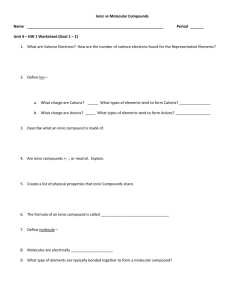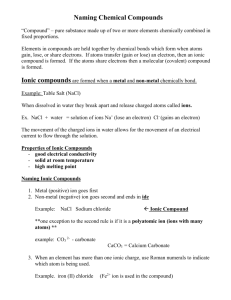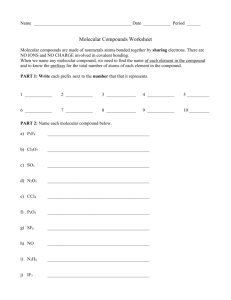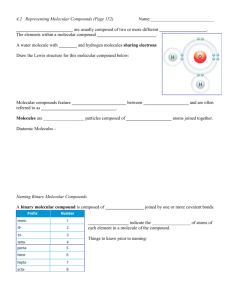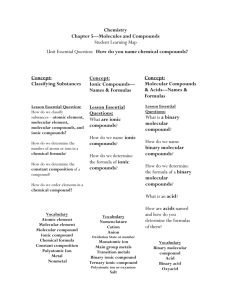Unit 6: Ch6.3b – Guided Notes
advertisement
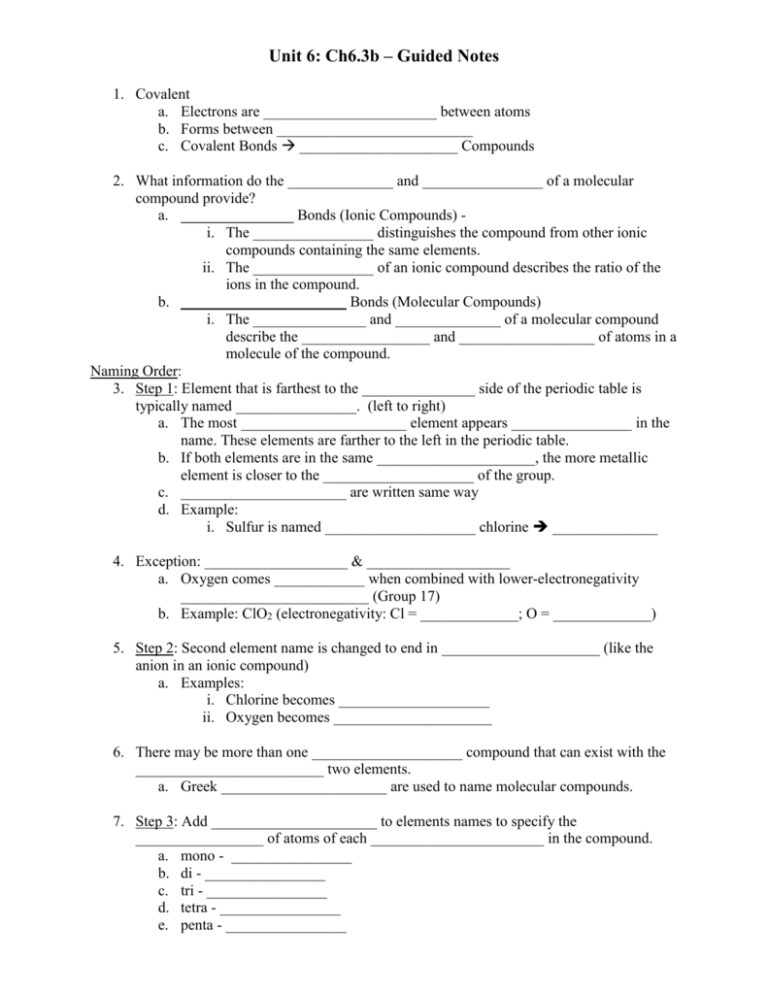
Unit 6: Ch6.3b – Guided Notes 1. Covalent a. Electrons are _______________________ between atoms b. Forms between __________________________ c. Covalent Bonds _____________________ Compounds 2. What information do the ______________ and ________________ of a molecular compound provide? a. _______________ Bonds (Ionic Compounds) i. The ________________ distinguishes the compound from other ionic compounds containing the same elements. ii. The ________________ of an ionic compound describes the ratio of the ions in the compound. b. ______________________ Bonds (Molecular Compounds) i. The _______________ and ______________ of a molecular compound describe the _________________ and __________________ of atoms in a molecule of the compound. Naming Order: 3. Step 1: Element that is farthest to the _______________ side of the periodic table is typically named ________________. (left to right) a. The most ______________________ element appears ________________ in the name. These elements are farther to the left in the periodic table. b. If both elements are in the same _____________________, the more metallic element is closer to the ____________________ of the group. c. ______________________ are written same way d. Example: i. Sulfur is named ____________________ chlorine ______________ 4. Exception: ___________________ & ___________________ a. Oxygen comes ____________ when combined with lower-electronegativity _________________________ (Group 17) b. Example: ClO2 (electronegativity: Cl = _____________; O = _____________) 5. Step 2: Second element name is changed to end in _____________________ (like the anion in an ionic compound) a. Examples: i. Chlorine becomes ____________________ ii. Oxygen becomes _____________________ 6. There may be more than one ____________________ compound that can exist with the _________________________ two elements. a. Greek ______________________ are used to name molecular compounds. 7. Step 3: Add ______________________ to elements names to specify the _________________ of atoms of each _______________________ in the compound. a. mono - ________________ b. di - ________________ c. tri - ________________ d. tetra - ________________ e. penta - ________________ f. g. h. i. j. hexa - ________________ hepta - ________________ octa - ________________ nona - ________________ deca – ________________ 8. Example: a. Both Compounds contain __________________ and _______________________ i. N2O _____________________________________ ii. N4O5 _____________________________________ 9. _________________________ to Step 3– ________________ prefix is used if there is only _______________________ atom of the 1st element in the compound. a. CO _____________________________________ b. CO2 _____________________________________ c. SO10 _____________________________________ 10. More Examples: a. N2Cl5 _____________________________________ b. N2O5 _____________________________________ c. P5Cl6 _____________________________________ d. SO10 _____________________________________ Writing Molecular Formulas: 11. Step 1: Write the symbols for the elements in the _____________ the elements appear in the ________________________. 12. Step 2: Write the _____________________ value of the prefixes as __________________ for the corresponding element in the ______________________. a. The prefixes indicate the _________________ of atoms of each ______________ in the molecule. b. If there is __________ prefix for an element in the name, there is only ______________ atom of that ______________________ in the molecule. 13. Examples: a. Diphosphorus Pentoxide ________________________. b. Silcon Dioxide ________________________. c. Carbon Tetrachloride ________________________. d. Trineptunium Octoxide ________________________. 14. Give the formula for: a. Oxygen Difluoride b. Phosphorus Tribromide c. Trisilicon Tetranitride 15. Give the Name for: a. NO2 b. N2O3 c. SO3




